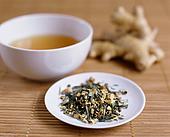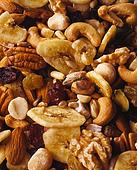 If you have a sensitive digestive system, you may spend most of the year following a specific diet to keep your body in balance. However, it is possible that during this time of year, you may find it much harder to keep your body in balance because of holiday parties, family gathering and the abundance of yummy food.
If you have a sensitive digestive system, you may spend most of the year following a specific diet to keep your body in balance. However, it is possible that during this time of year, you may find it much harder to keep your body in balance because of holiday parties, family gathering and the abundance of yummy food.
Even if you follow a gluten-free diet, it is still easy to overdo it on the delicious gluten-free baked goods! I personally have found this true for myself during this time of year. On top of the holidays, we just finished celebrating my husband’s birthday and my son’s 1st birthday. I made gluten-free chocolate cupcakes with coconut-cashew icing. They were delicious and very easy to overindulge on.
So, if you find yourself overindulging this holiday, and are feeling the consequences that night or the next day, here are some home remedies to help you get your system back in balance:
Ginger root:
Ginger has been used for centuries to help with digestion. It can help with nausea, stomachaches, gas or  constipation and it “helps break down proteins to rid the stomach and intestines of gas. It also aids in the digestion of fatty foods.” Source
constipation and it “helps break down proteins to rid the stomach and intestines of gas. It also aids in the digestion of fatty foods.” Source
Make ginger tea:
When making tea, always use fresh ginger root sold in the produce section of your grocery store. Peel the skin with a paring knife and then grate about once inch. Bring about 4 cups of water to a boil, add the grated ginger and reduce to a simmer. Cook for 15 minutes or so, or until it has a strong, spicy flavor. Strain the ginger into your cup and add honey or agave to sweeten. If the ginger is too strong for you, dilute it with some water.
 Lemons:
Lemons:
“The acidity in lemons also has healing powers, especially with many digestive problems. Lemon, when mixed with hot water, can cure nausea, heartburn, constipation and diarrhea, worm infestations of the lower intestines, bloating, and belching. It also stimulates the liver to produce the correct amount of bile, which helps with digesting food.” Source
I personally love adding the juice of one half to one whole lemon to a cup of boiling water. I add honey or maple syrup to sweeten. Adding in 1-2 dashes of cayenne also helps to clear out your system. This is known as the Master Cleanse – lemon juice, maple syrup, and cayenne. People fast on this drink for 10 days; however, you can drink it in the morning and then eat lightly the rest of the day or do a partial cleanse. It will still help to restore balance in your body.
Apple cider vinegar:
Traditional forms of vinegar that still have the “strands” present in them are also very healing. The “strands” are the little bits floating in the bottom of the jar. Apple cider vinegar is one of these healing vinegars and can help restore balance in your body as well. Here is some great information.
My friend and business consultant, Dawud Miracle, gave me the following recipe for when he wants to enjoy certain foods he knows he may have a reaction to it. He uses it particularly when he wants to enjoy pizza because the combination of the wheat and dairy causes a reaction in his body.
Mix 2 Tablespoons of apple cider vinegar in 8oz of water. Usually I take right after a meal and then a couple hours later. It really cuts the intolerance.
These are just a few remedies. There are many more herbs and foods that can help with your digestion and restore balance in your body after the holiday dinner parties. If you have additional ideas, please don’t feel shy to post your comment!
Happy Holidays!
